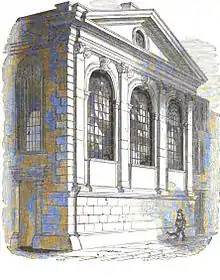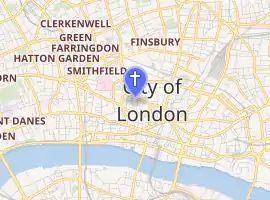St Michael Wood Street
St Michael’s Wood Street was a church and parish of medieval origin in Cripplegate Ward in the City of London, and is first mentioned in 1225 as St. Michael de Wudestrate.[1] It stood on the west side of Wood Street, initially with a frontage on Huggin Lane but later on Wood Street itself.[2]
| St. Michael Wood Street | |
|---|---|
 | |

| |
| Location | London |
| Country | United Kingdom |
| Denomination | Church of England |
| Architecture | |
| Architect(s) | Christopher Wren |
| Style | Baroque |
| Demolished | 1897 |
After King James IV of Scotland was killed at the Battle of Flodden in 1513, his head was brought to London and hastily buried in this church.[3][4] John Stow admired the building, and called it a "proper thing".[5]
The church was destroyed in the Great Fire of London,[6] and after some pressure[7] it was rebuilt by Sir Christopher Wren in 1673.[8] The organ was built by Thomas Elliot in 1800: the most noted organist was Dr Henry Hiles.[9]
In 1854 the declining residential population led to proposals to reduce the number of churches within the "Square Mile"[10] - a procedure the church's vicar had himself proposed.[11] The church was eventually demolished under the auspices of the Union of Benefices Act[12] in 1897,[13] and many bodies were disinterred from the churchyard and reburied at Brookwood Cemetery.[14]
The parish was then united with St Alban Wood Street,[15] and, after the destruction of that church in World War II, with St Vedast Foster Lane.[16]
The site has undergone several redevelopments: as of 2020, it is the site of a low-rise commercial building.
Bibliography
- 'Church of England, Parish of St. Michael Wood Street. - Assessment of the annual tithes of the joint parishes of St. Michael Wood St, 1671'. - M0014588CL cited in City of London Parish Registers Guide 4
Ministers of the church
- John Ive, fl 1399 [17]
See also
- List of Christopher Wren churches in London
- List of churches rebuilt after the Great Fire but since demolished
References
- H.A. Harben, A Dictionary of London (Herbert Jenkins, London 1922)
- "The Survey of Building Sites in London after the Great Fire of 1666" Mills, P/ Oliver, J Vol I p7: Guildhall Library MS. 84 reproduced in facsimile, London, London Topographical Society, 1946
- Dr. Tony Pollard (8 September 2013). "The sad tale of James IV's body". BBC News Scotland. Retrieved 9 September 2013.
- G. Huelin, Vanished Churches of the City of London (Guildhall Library Publishing, London) 1996ISBN 0900422424
- W. Thoms (ed.), John Stow's A Survey of London (A Whittaker & Co, London 1842) (original 1598).
- Reynolds, 1922
- A. Hallows (ed.), (London, Guildhall Library Research, 1974) ISBN 0-900422-30-0
- M. Whinney, Wren (Thames & Hudson, London 1971) ISBN 0-500-20112-9
- C.W. Pearce, Notes on Old City Churches: their organs, organists and musical associations (Winthrop Rogers Ltd, London 1909)
- 'Proposed Removal Of Thirty City Churches', The Times, Wednesday 4 January 1854 (Issue 21629), p. 5, column F.
- C. Hume, Proposal for supplying the Suburbs of London with some of the Churches not required in the City (London, 1853)
- C. Hibbert, D. Weinreb and J. Keay, The London Encyclopaedia (Pan Macmillan, London, 1983) (revised 1993, 2008) ISBN 978-1-4050-4924-5
- G. Cobb, The Old Churches of London (London, Batsford, 1942).
- J.M. Clarke, The Brookwood Necropolis Railway (Oasdale, Usk, 2006) ISBN 978-0-85361-655-9
- P. Norman, On the destroyed church of St. Michael Wood street in the City of London (The Society, London 1902)
- J. Betjeman, The City of London Churches (Andover, Pitkin, 1972) ISBN 0-85372-112-2
- Plea Rolls of the Court of Common Pleas: The National Archives (UK) CP 40/555, Year 1399 (first term of Henry IV), 4th entry, county margination "london": John Ive, parson, as plaintiff